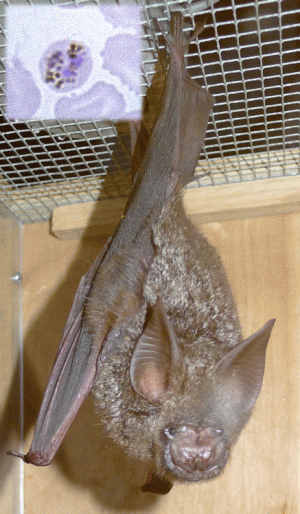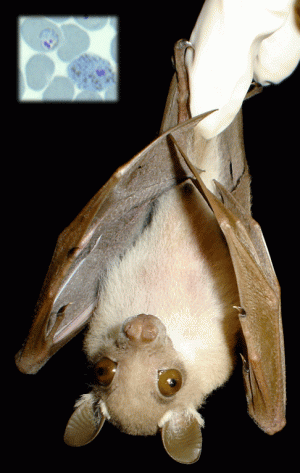West African bats—no safe haven for malaria parasites

In Europe, bats are normally discussed in the context of endangered species threatened by loss of their habitats. However, in recent years, bats have caught the eye of infection biologists. The animals are namely hosts to a surprising number of pathogens, many of which could be dangerous to humans. Scientists at the Max Planck Institute for Infection Biology, the Museum für Naturkunde in Berlin and the American Museum of Natural History have been able to identify in West African bats four genera of parasites that are closely related to the malaria pathogen. One of them is the genus Plasmodium, which also includes the species that cause malaria in humans. The Plasmodium species in bats are very similar to that found in rodents and could advance the study of malaria pathogens' defence strategies against immune system responses.
Bats can transmit various diseases to human beings. Indeed, they serve as reservoir hosts for a long list of pathogens, including the "who's who" of dreaded killer viruses: Ebola, Marburg, Nipah, Hendra and Lyssa. The SARS outbreak in 2002 in Asia and the transmission of a previously unidentified virus (MERS) to humans in the Middle East in 2013 can both be traced back to viruses that have switched hosts from bats to humans. Bats have an exceptional immune system that can hold all these viruses in check. However, some infections in humans often have a deadly outcome.
Recently, the researchers have also found an astonishing variety of blood parasites in West African bats. They examined 31 bat species from the West African forest in Guinea, Liberia and the Ivory Coast with regard to parasites that attack red blood cells. 40 per cent of the approximately 270 examined animals carried parasites of the genera Plasmodium, Polychromophilus, Nycteria and Hepatocystis. According to the study, at least two species of Plasmodium can be found in bats. These bat pathogens are very similar to those found in rodents. "There are different arboreal rodents in the tropics that live in close vicinity to bats and in result might attract the same mosquitoes that transmit parasites from one group of animals to another," says Juliane Schaer from the Max Planck Institute in Berlin.
Plasmodium parasites cause malaria, the most important vector-borne infectious disease on the planet. These protozoan parasites reproduce in different host cells and undergo a complex life cycle in two alternating hosts. Their sexual reproduction takes place in insects; usually Anopheles mosquitoes. Following a mosquito bite, they reproduce asexually in different vertebrates. By comparing DNA, the scientists were able to establish a phlyogenetic tree for haemosporidians in bats. This showed that bats were the first mammal hosts to the pathogens. "In a later evolutionary stage, they switched to rodents and primates," Susan Perkins from the American Museum of Natural History in New York says.

It is not yet clear why bats are hosts to such a multitude of microorganisms. "One reason is probably that, in evolutionary terms, this is a very old group of animals, which moreover comprises a large number of different species. The bats' ability to fly and their tendency to form big colonies are other factors that help the parasites spread," explains Schaer.
As a consequence of the pathogen threat, bats have developed a sophisticated immune system. This might explain the finding that certain bat species show infection rates of over 60 per cent by haemosporidians and still manage to keep the parasites at bay without becoming ill. "Also, the fast asexual reproduction of the genera Polychromophilus, Nycteria and Hepatocystis in bats takes place in hepatocytes, and not in erythrocytes as in humans. Such a liver stage cannot be clinically detected in humans. "It may be that the effective immune system ousted the pathogens from the blood cells, so that they were limited to multiply in the liver," says Kai Matuschewski, Leader of the Parasitology Research Group at the Max Planck Institute for Infection Biology.
For the scientists, the bat haemosporidians offer an opportunity for studying how the pathogens adapt to new organisms and thus also the immune responses of an organism. In addition, they hope to learn more about malaria parasites in humans. Many studies focussing on vaccines and antimalarial drugs make use of mouse models. As the parasites found in bats are so similar to those in rodents, it may be easy to transfer them to mice and study them closer.
More information: High diversity of West African bat malaria parasites and a tight link with rodent Plasmodium taxa Juliane Schaer, Susan L. Perkins, Jan Decher, Fabian H. Leendertz, Jakob Fahr, Natalie Weber, and Kai Matuschewski, PNAS, 22 October 2013
Journal information: Proceedings of the National Academy of Sciences
Provided by Max Planck Society




















